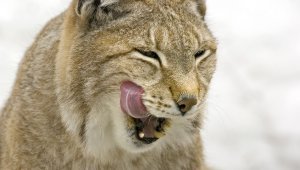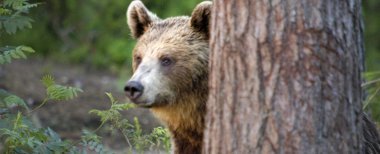Meeting a bear
A brown bear is usually on the move early in the morning and in the evenings. When a human comes across a bear in the wild, it is usually because the bear got taken by surprise; it tries to steer clear of people. With its excellent smell and hearing the bear will usually sense a human from far away and either hide or leave the scene.
Main objectives of Management Plan for Bear Population are to preserve favourable conservation status of bear population and ensure that bears will not lose fear of humans
Fri Jul 08 15:36:00 2022
Bear used to be threatened in Finland, and now it is strictly protected under the Habitats Directive. It is a highly respected part of the Finnish fauna. It is also a valuable game animal that is being hunted every year for population management purposes. Hunting has not prevented the maintenance of a favourable conservation status, which the bear has held since 2000.
The measures of the Management Plan for the Bear Population approved on 7 July is to respond to the needs of both people living in areas inhabited by bears and the protection of the bear population.
“The main objective of the management of the bear population is to maintain its favourable conservations status and ensure that bears will not lose their fear of humans. Studies show that, as a rule, bears tend to avoid humans in Finland, and it is important to keep it that way,” says Vesa Ruusila, Senior Ministerial Adviser at the Ministry of Agriculture and Forestry.
The measures of the Management Plan concern e.g. monitoring of the population, population management measures, prevention of damages and management of conflicts, official assistance to the police by game management associations (SRVA), stakeholder cooperation and communication.
Of the studies related to bear, the Management Plan describes the ongoing two-year project of the Natural Resources Institute Finland to develop a supplementary method based on the genetic identification of individuals for monitoring the bear population. Voluntary work has an important role in collecting DNA samples of bears and in the bear and other large carnivore sightings by large carnivore contact persons.
The Management Plan also deals with food baits, which have become increasingly common, partly because of camera traps. According to the Management Plan, a broad-based project led by the Ministry of Agriculture and Forestry will be launched to study the use of food baits for viewing purposes and the possible need to create harmonised practices together with various stakeholders.
“We have found it necessary to study especially the use of food baits for bears together with stakeholders and to examine the available scientific knowledge and data on this matter. Food baits are used by both private persons and companies and they have various kinds of ecological, economic and social impacts. A harmonised practice is needed for their use,” Ruusila says.
Implementation of the Management Plan
The main responsibility for the implementation of the Management Plan for the Bear Population in Finland rests with the Finnish Wildlife Agency, Natural Resources Institute Finland and Ministry of Agriculture and Forestry. There will be a designated person at the Finnish Wildlife Agency to coordinate and monitor the implementation of the Management Plan.
The Management Plan was updated in cooperation between the Finnish Wildlife Agency and Natural Resources Institute Finland and it was circulated for comments in 2017. The statements received, 13 in total, were taken into account when finalising the Management Plan. The Ministry of Agriculture and Forestry organised a stakeholder event in June 2022 to discuss the finalised draft for the Management Plan. The previous Management Plan for the Bear Population dates back to 2007.
Inquiries:
7–15 July 2022: Henna Väyrynen, Specialist, Unit for Recreational Use of Nature, Ministry of Agriculture and Forestry, henna.vayrynen@gov.fi, tel. +358 295 162 014
11–22 July 2022: Sami Niemi, Ministerial Adviser, Unit for Recreational Use of Nature, Ministry of Agriculture and Forestry, sami.niemi@gov.fi, tel. +358 295 162 391
Links:
Management Plan for the Bear Population in Finland (Link to an external website) The English language version will be available in the autumn.
Report a sighting
A large carnivore sighting can consist of seeing the animal itself, or spotting the tracks, droppings, carcasses, claw marks or other signs left behind by the carnivore somewhere in the wilds. By reporting your sighting you are taking part in game animal research. Every year tens of thousands of sig...
Large carnivores in populated areas & road accidents
A large carnivore that causes damage, repeatedly acts in a problematic manner or ventures into a populated area must always be reported to the emergency exchange (tel: 112). The primary aim is to scare the predator away from coming too close to populated areas. The animal is only put down if it is b...
Damage prevention
Occasionally large carnivores cause damages to domestic animals. Livestock and hunting dogs are the most common targets. However, a significant portion of large carnivore damages may be avoided with the right kind of preventive measures.

